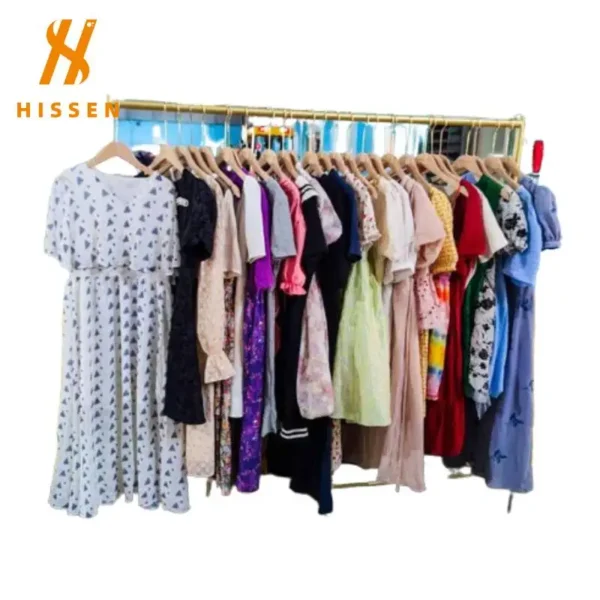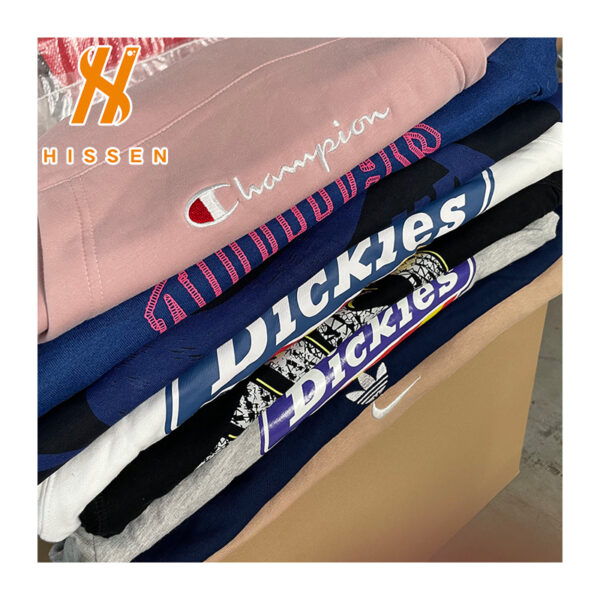I. Introduction
The concept of a secondhand clothing wholesale business revolves around the buying and selling of pre-owned garments in bulk quantities to retailers, resellers, and other businesses. In recent years, there has been a notable shift in consumer attitudes towards sustainable fashion and a growing demand for affordable clothing options. This trend has created a flourishing market for secondhand clothing, opening up opportunities for entrepreneurs to establish their own wholesale ventures in this sector.
Secondhand clothing wholesalers play a significant role in the fashion industry’s circular economy by prolonging the lifecycle of garments and reducing waste. Instead of ending up in landfills, gently used clothing items are given a second chance through the wholesale channel. These businesses source their inventory from various channels, including thrift stores, consignment shops, online marketplaces, or direct partnerships with individuals. They then distribute these clothing items to retailers or resellers who can further sell them to end consumers.

II. Market Research
A. Identify target customers and their preferences in the secondhand clothing market.

B. Analyze competitors in the secondhand clothing wholesale industry.

C. Identify specific clothing categories or niche markets to focus on
III. Business Planning
Define Your Business Goals and Objectives:
Determine your long-term vision for the business.

Conduct market research to understand the preferences and needs of your target customers.
Outline your company’s mission, vision, and core values.
Identify and establish relationships with reliable suppliers of secondhand clothing.
Develop efficient systems for inventory tracking, storage, and organization.
Build a strong brand identity that resonates with your target market.
Establish efficient order processing and fulfillment systems.
Focus on delivering exceptional customer service to build trust and loyalty.
Regularly evaluate and reassess your business strategy and adapt to market trends.
IV. Legal and Operational Considerations
Considerations for Legal and Operational Aspects of Secondhand Clothing:
-
Legal Compliance:
- Register your business and obtain the necessary licenses and permits.
- Comply with local and national business laws and regulations, including consumer protection and product safety standards.
- For imports or cross-border trade, understand relevant customs and trade regulations, and adhere to import procedures and requirements.
-
Product Quality and Safety:
- Implement strict quality control measures to ensure that secondhand clothing meets customer expectations.
- Inspect, clean, and repair the clothing items to ensure they are suitable for resale.
- Address any safety issues such as damaged zippers or buttons that may pose a risk to users.
-
Intellectual Property:
- Avoid infringing on brand trademarks, copyrights, or design patents.
- Ensure the legality of purchased and sold secondhand clothing, avoiding sales of stolen, counterfeit, or infringing products.
-
Data Protection:
- Properly manage customer and supplier personal data, ensuring compliance with relevant data protection regulations.
- Implement appropriate security measures to protect the confidentiality and integrity of sensitive information.
-
Operations and Logistics:
- Establish efficient inventory management systems, tracking stock quantities, locations, and sales records.
- Design effective order processing and logistics processes to ensure timely delivery of customer orders.
- Manage returns and after-sales services, handling customer complaints and issues.
-
Environmental Compliance:
- Comply with relevant environmental protection regulations, such as proper waste disposal and handling of hazardous substances.
- Adopt sustainable business practices, promoting circular economy principles and reducing resource waste.
To ensure the legality, sustainability, and a good reputation for your secondhand clothing wholesale business, it is crucial to collaborate with legal advisors, gain a deep understanding of local laws and regulations, and adhere to best operational practices.
V. Building Supplier Relationships
Conduct market research to identify potential suppliers of used clothing.
Clearly communicate your business values, mission, and objectives to potential suppliers.
Schedule visits to potential suppliers’ locations to assess their operations and inventory.
Engage in open and transparent discussions about pricing, payment terms, and order quantities.
Maintain open lines of communication with suppliers to address any concerns, discuss inventory needs, or resolve issues promptly.
Foster trust by consistently fulfilling payment obligations and maintaining professional conduct.
Engage in collaborative discussions with suppliers to explore opportunities for process improvements, inventory diversification, or innovative solutions.
VI. Marketing and Sales Strategies
Define your brand identity and value proposition that differentiates your business from competitors.
Create a user-friendly and visually appealing website or e-commerce platform to showcase your inventory.
Create informative and engaging content related to sustainable fashion, styling tips, and trends.
Identify your target audience and utilize targeted advertising channels, such as social media ads or Google Ads.
Collaborate with complementary businesses, such as fashion retailers or stylists, to cross-promote each other’s offerings.
Provide exceptional customer service and respond promptly to inquiries, feedback, and complaints.
Utilize analytics tools to track website traffic, customer behavior, and sales performance.
Showcase customer testimonials, reviews, and case studies to build trust and credibility with potential buyers.
VII. Customer Acquisition and Retention
Customer acquisition and retention are vital for the success and growth of a used clothing wholesale business. Here are some strategies to consider:
-
Targeted Marketing Campaigns:
- Identify your target audience and develop tailored marketing campaigns to reach them effectively.
- Utilize various channels such as social media, online advertising, email marketing, and search engine optimization.
- Create compelling content and offers that resonate with your target market’s interests, values, and needs.
-
Referral Programs:
- Implement a referral program that incentivizes existing customers to refer new customers to your business.
- Offer rewards or discounts to customers who refer others, and ensure a positive experience for both referrers and new customers.
-
Personalization and Customer Segmentation:
- Segment your customer base based on demographics, purchase behavior, or preferences.
- Customize marketing messages and offers to target specific segments, providing a personalized experience that resonates with individual customers.
-
Exceptional Customer Service:
- Deliver exceptional customer service that exceeds expectations and builds trust.
- Train your customer service team to be knowledgeable, friendly, and responsive.
- Respond promptly to inquiries, complaints, and feedback, addressing customer concerns and resolving issues effectively.
-
Loyalty Programs:
- Implement a loyalty program to reward and retain loyal customers.
- Offer exclusive discounts, early access to new arrivals, or special promotions for program members.
- Engage with loyalty program members through personalized communications and targeted offers.
-
Enhance the Shopping Experience:
- Focus on creating a seamless and enjoyable shopping experience for customers.
- Optimize your website or e-commerce platform for easy navigation, fast loading times, and intuitive product search.
- Provide detailed product descriptions, high-quality images, and size guides to help customers make informed purchasing decisions.
-
Follow-up and Engagement:
- Stay in touch with customers through email newsletters, social media updates, or personalized messages.
- Share relevant content, fashion tips, and new arrivals to keep customers engaged and interested in your offerings.
- Seek customer feedback and implement improvements based on their suggestions.
-
Customer Retention Programs:
- Develop customer retention programs to encourage repeat purchases and foster long-term relationships.
- Offer incentives such as exclusive discounts, free shipping, or birthday rewards for returning customers.
- Use customer data to personalize communications and recommendations based on their previous purchases.
-
Continuous Improvement:
- Monitor customer satisfaction metrics, such as Net Promoter Score (NPS) or customer feedback ratings.
- Analyze customer data to identify patterns, preferences, and opportunities for improvement.
- Regularly evaluate and adapt your customer acquisition and retention strategies based on insights gained from customer behavior and market trends.
Remember, acquiring new customers is important, but retaining existing customers is equally crucial. By implementing effective customer acquisition and retention strategies, you can foster customer loyalty, drive repeat purchases, and create a strong customer base for your used clothing wholesale business.
VIII. Scaling and Growth
Scaling and achieving growth are important objectives for a used clothing wholesale business. Here are some strategies to consider for scaling and achieving sustainable growth:
-
Expand Product Offerings:
- Diversify your inventory by adding new categories, styles, and sizes of used clothing.
- Stay updated on fashion trends and customer preferences to ensure your product offerings are in line with market demands.
- Consider partnering with other wholesalers or suppliers to access a wider range of clothing options.
-
Explore New Markets:
- Identify new target markets or geographic regions to expand your customer base.
- Conduct market research to understand the preferences, purchasing behaviors, and competition in those markets.
- Tailor your marketing and sales strategies to effectively reach and engage customers in new markets.
-
E-commerce and Online Marketplaces:
- Leverage e-commerce platforms and online marketplaces to reach a broader customer base.
- Optimize your online presence, including your website and product listings, to attract and convert online shoppers.
- Consider selling through popular online marketplaces that specialize in used clothing or fashion items.
-
Strategic Partnerships:
- Collaborate with complementary businesses to expand your reach and gain access to new customer segments.
- Form partnerships with fashion retailers, stylists, or influencers who can promote and recommend your products.
- Explore opportunities to join forces with organizations or platforms focused on sustainability or ethical fashion.
-
Streamline Operations:
- Review and optimize your operational processes to increase efficiency and productivity.
- Invest in inventory management systems, warehouse organization, and order fulfillment automation to handle increased volume effectively.
- Continuously assess and improve your supply chain to ensure a steady flow of quality used clothing.
-
Customer Retention and Referral Programs:
- Implement loyalty programs and referral incentives to encourage repeat purchases and customer advocacy.
- Nurture and maintain strong relationships with existing customers through personalized communication, exclusive offers, and exceptional customer service.
- Leverage satisfied customers to generate referrals and positive word-of-mouth marketing.
-
Data Analytics and Insights:
- Utilize data analytics tools to gain insights into customer behavior, purchasing patterns, and market trends.
- Monitor key performance indicators (KPIs) such as sales conversion rates, customer acquisition costs, and customer lifetime value.
- Use data-driven insights to make informed decisions and optimize your marketing, sales, and operational strategies.
-
Continuous Innovation and Adaptation:
- Stay agile and adapt to changing market dynamics and customer needs.
- Innovate in areas such as sustainable packaging, delivery options, or value-added services to differentiate your business.
- Monitor industry trends and emerging technologies that can enhance your operations and customer experience.
-
Financial Planning and Investment:
- Develop a comprehensive financial plan that considers revenue projections, expenses, and cash flow requirements for scaling.
- Secure appropriate funding or investment to support expansion plans, such as inventory expansion, marketing initiatives, or infrastructure upgrades.
Remember, scaling and growth require careful planning, strategic decision-making, and continuous evaluation of performance. Regularly assess and adjust your strategies as you scale, while keeping a focus on maintaining product quality, customer satisfaction, and sustainable business practices.
IX. Conclusion
In conclusion, starting and growing a successful used clothing wholesale business requires careful consideration of various aspects. From understanding the concept of the business to conducting market research, adhering to legal requirements, and implementing effective marketing and sales strategies, each step plays a crucial role in achieving success. Building strong supplier relationships, focusing on customer acquisition and retention, and implementing scalable strategies for growth are essential for long-term sustainability.
Additionally, considering legal and operational aspects, such as complying with laws and regulations, ensuring product quality and safety, protecting intellectual property, and managing data responsibly, are integral to running a lawful and ethical business.
By prioritizing customer satisfaction, embracing sustainability, and staying adaptable to market trends, you can differentiate your business and create a positive reputation in the industry. Continuously monitoring and evaluating performance, analyzing data, and making data-driven decisions will enable you to optimize your operations, identify growth opportunities, and adapt to evolving customer demands.
Remember, building a successful used clothing wholesale business requires dedication, perseverance, and a commitment to providing value to customers while maintaining ethical and sustainable practices. By staying informed, fostering strong relationships, and continuously improving, you can position your business for long-term growth and success in the dynamic and competitive used clothing market.



